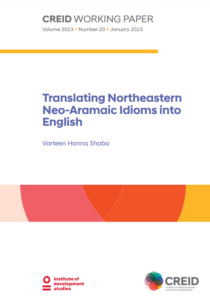Heritage is commonly perceived as being about a passive preservation of the past, passed down from one generation to the next. In reality, however, heritage is dynamic and shaped by the ways in which we choose to use and interpret it. This possibility of change and adaptation makes it very much of the present and provides opportunities for young people to engage with their culture and identities.

Yazidi temple destroyed by Daesh in Bashiqa, northern Iraq. For their personal safety, the photographer would like to remain anonymous.
In Iraq, recent conflicts have meant that the heritage of minority religious communities has come under increasing threat. This is because cultural genocides often precede human genocides.
Despite the devastation wrought by Daesh on the Yezidi populations and their heritage throughout Sinjar, Mosul and the Nineveh Plains, the youth of Bashiqa town, sought to reclaim their town and deny Daesh their victory of eradicating the Yezidi and Christian presence in the region by reconstructing and rehabilitating of their heritage.
I began working with Yezidi youth from Bashiqa in 2018 as part of my research exploring the impacts of heritage destruction on local communities.
During this research I was struck by their resilience and passion as the young people explained how, once Bashiqa had been liberated from Daesh, they set about documenting the heritage destruction that had occurred and formed teams to rehabilitate the sites. They described the importance of the shrines and churches and why these were the spaces they prioritised once they returned to Bashiqa:
“[W]hat the community of Bashiqa did is to start building these shrines again as a message to Islamic State: we are still here and we will still resist. So, the shrines in Bashiqa have been built by the donation of the people […] not by the government or any NGOs. So, people of Bashiqa raise money […]and they are starting to build shrines one by one and they start celebrating in the completion of any new shrine in a kind of festival where you can find all the community […]. Some people asked them why are you building a shrine before the houses? Because we had many houses that had been destroyed. [But] if you build the shrine, you are building a place […] for the whole town and for the whole people. Because the shrine belongs to everybody in Bashiqa and not to a specific person […]. That’s why you can see all the people cooperate together to build the shrines first to say that Bashiqa still belongs to minorities or Yezidis and we start cleaning the church together to say the church also will stand in the town.”*
Reconstructing the temples and churches of Bashiqa was essential for the youth I spoke to as a means of regaining some of what had been lost to them in terms of memory, history, and community.
The renovation of the shrines and churches was also important for the community to encourage people to return to the town and to instil the hope that they could have a home again.
“We wanted to encourage people to come back and to give them spirit to motivate them for that by cleaning the city. And this […] encouraged people to come back to Bashiqa, many of them came back”.*
Amidst a deficit of basic infrastructure including shelter, water and electricity, it may appear strange that heritage was such a significant factor; yet, the role of heritage in building identity, community and place made this a priority for those from Bashiqa.
For heritage professionals, rebuilding is a conflicted and complicated process: with questions around how rebuilding will be financed, what methods and materials will be used, and exactly what is being reconstructed – the site as it was when it was initially built, or how it was just prior to its destruction? In spite of these dilemmas, efforts are already underway to restore parts of Palmyra in Syria while in Iraq, UNESCO have initiated the campaign ‘Revive the Spirit of Mosul’ and earmarked two sites that were destroyed by Daesh for reconstruction.
In The Cultural Politics of Emotion, feminist scholar Sara Ahmed describes how
“[A] good scar allows healing, it even covers over, but the covering always exposes the injury, reminding us of how it shapes the body. Our bodies have been shaped by their injuries, scars are traces of those injuries which persist in the healing or stitching of the present. This kind of good scar reminds us that recovering from injustice cannot be about covering over the injuries, which are the effects of that injustice.” [p202]
Consequently, when facing the emotional scars resulting from heritage destruction, reconstruction efforts require a nuanced approach that asks, “what makes a good scar?” by balancing memories of heritage spaces with memories of their destruction.
This means that the priority could be less on what might be seen as the authenticity of design and materials and more on enabling continuity of practice. It highlights the importance of understanding local perspectives and needs in the aftermath of conflict, and that change can be a vital part of the history of a heritage site. Consequently, such places do not always need to be preserved in stasis or rebuilt by experts in a manner true to their original form. Instead, the destruction can be remembered through the alterations and the process of restoration used as a means of reconfiguring the social components of community.
Among the Yezidi youth from Bashiqa the reconstruction of their heritage was not about a return to a past or place before destruction, as the scars of the community witnessed on the landscape could not simply be removed. This reconstruction was about a forward-looking means of creating their community anew.
*Quotes are from those interviewed as part of Sofya’s PhD research. Interviewees wish to remain anonymous for their own safety.

